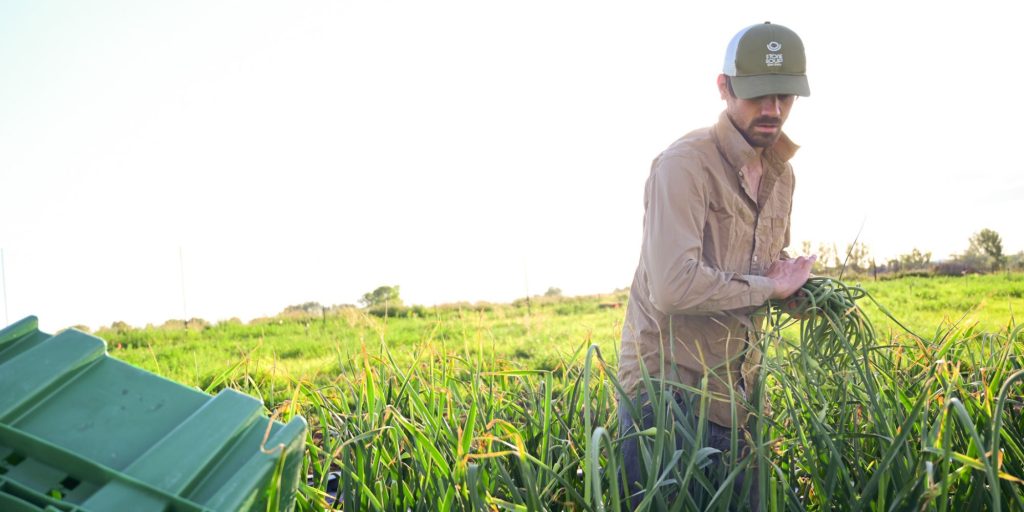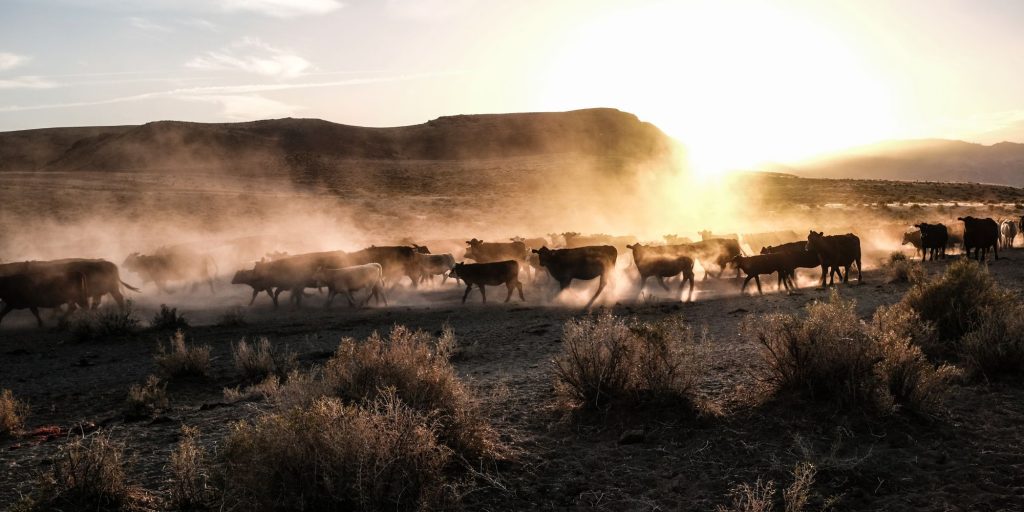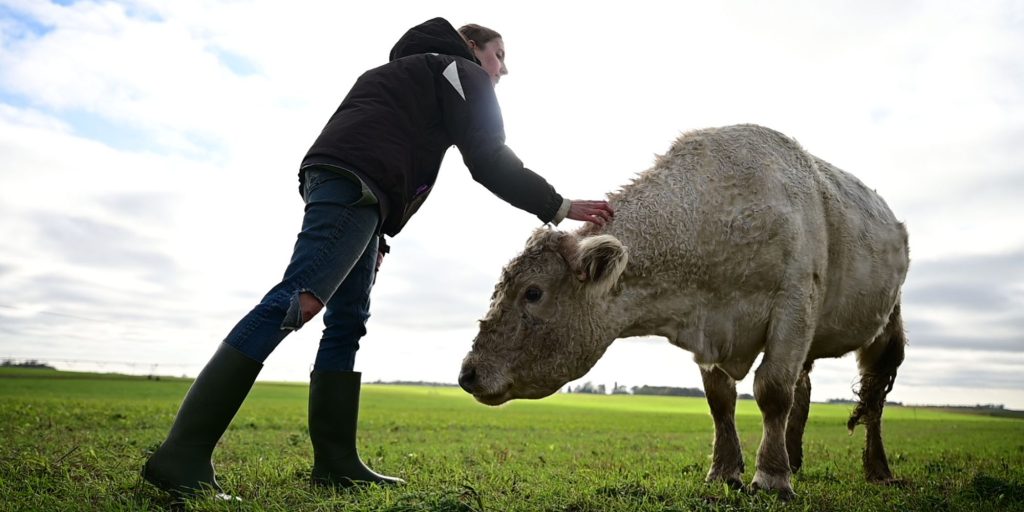Congress must pass a new Farm Bill that prioritizes a diverse and resilient food system, ensures fairness, and builds a sustainable and secure food supply for all Americans.
The Farm Bill is a package of federal legislation enacted every five to seven years to set the general direction for America’s farm and food policy. The Farm Bill is much more than an agricultural aid package – in fact, it influences every American every day. Policies in the Farm Bill help determine what type of food is available to how much it costs, and the tools available to your community to protect farm and ranch land and promote renewable energy and energy efficiency. Farm Bill policy is intended to ensure fair markets and prices for family farmers and ranchers, and provide nutrition assistance to hungry families and schoolchildren.
Over the last three decades, farm policy has worked to support exponential growth for corporate agribusiness at the expense of family farmers and consumers. At the same time that deregulation put midsized, independent farm families at the mercy of wild market fluctuations, unchecked consolidation compounded the problem. Unrestrained mergers have led to a system in which a few powerful corporations sit between two million American farmers and 331 million American consumers. There are just a handful of companies that buy crops and livestock from farmers, and their disproportionate market power allows them to lower the prices farmers receive without factoring in the farmers’ costs In the retail sector, according to the USDA Economic Research Service, in 2019 just eight mega corporations controlled over 50% of the market share of grocery store sales (with the top four controlling over 30%), ensuring that these lowered farm prices are not passed on to consumers. And it won’t stop there; the imminent merger between Kroger and Albertsons is projected to increase corporate market control to 11.8%, shut down stores, and result in layoffs.
Keep up to date with grassroots organizing in the West with WORC’s newsletter.
Since the last Farm Bill in 2018, Americans have endured the global Coronavirus pandemic revealing the fragility of our domestic supply chains. Russia’s invasion of Ukraine further exposed the vulnerability of our international food systems, and continued droughts across the west increasingly threaten our rural communities. At this critical juncture, targeted policy shifts are essential to create a more sustainable environment, help family farms, ranches and related businesses thrive, ensure food security at home and abroad, and fight climate change.
It is also critical that we support the next generation of farmers through beginning farmer and rancher programs and ensure that the federal Farm Bill policies and programs are accessible to all who need them. The U.S. needs more than one kind of farmer raising more than one kind of crop or animal. To stop the rapid degradation of farm and ranch land, the role of farmers as stewards of the land must be supported and encouraged. To support a sustainable and secure food supply for all Americans, Federal farm and food policy must promote sustainable practices for an array of farm sizes, production models, regions, supply chains and diversified crop cultivation
To achieve this, federal food and farm policy must support and reflect the diversity of our communities. Congress and The Department of Agriculture (USDA) must ensure full and fair access for socially disadvantaged and other underrepresented groups including beginning and Native American farmers and ranchers.
We urge Congress to pass a Farm Bill before the current one expires on December 20th 2023 that prioritizes and incorporates the following concepts and policies.
Restore fair and competitive markets
Crop and livestock producers require a competitive and open marketplace so they are not beholden to corporate agribusiness. A fair and competitive marketplace should cover the cost of production, return reasonable profits for farmers and support fair pay for workers in plants and fields. This cannot happen without breaking up the agribusiness cartels who control seed, chemical, meatpacking, poultry and grocery chain markets. This requires vigorous enforcement of existing antitrust laws.
Our policy priorities include:
- Require USDA to publish and finalize the Farmer Fair Practices rules under GIPSA and restore the Competitive Injury Rule for farmers and ranchers seeking justice under the Packers and Stockyards Act.
- Restore GIPSA as an independent agency within USDA.
- Amend the Packers and Stockyards Act to prohibit the use of certain anti-competitive forward contracts as proposed in the Captive Supply Reform Act.
- Reinstate country-of-origin labeling for pork and beef.
- Adopt the OFF act as an amendment to the farm bill. Which would prevent checkoff boards from entering contracts with entities that engage in government relations work (lobbying), improve transparency of the distribution and use of checkoff funds, and institute regular audits.
Invest in truly sustainable energy solutions
To meet our climate and energy goals, farmers and rural communities will need to be a big part of the solution. Rural energy programs should focus on real rural energy solutions that also contribute to other environmental and community goals. The emphasis must be on more robust rural energy conservation efforts that can help farmers, ranchers and rural residents reduce
their energy use and their monthly energy costs. Support for renewable energy production should be focused on locally-owned, scaled and beneficial projects that are based upon sustainable resource planning and use, and enhance, rather than diminish our natural resources and economies.
- Protect and expand the $9.7 Billion allocated to the USDA Rural Utility Service for rural electric co-op energy transition projects.
- Boost investments in on-farm energy initiatives: increase funding for the Rural Energy for America Program (REAP), direct the USDA to study dual-use renewable energy and cropping or livestock systems, and move the AgSTARprogram to NRCS to provide technical assistance to farmers interested in reducing methane emissions through anaerobic digestion
Protect and target conservation funding
Conservation programs for working lands and the use of rotational production methods can provide market and environmental benefits. Conservation funds should be preserved and should subsidize the transition to and maintenance of farm management strategies that improve biodiversity, minimize air and water pollution, and conserve soil, water, and other essential resources. Conservation programs should help farmers identify crops and techniques appropriate to their region’s water resources and climate.
Our policy priorities include:
- Ensure the Conservation Stewardship Program (CSP) provides equal incentives for pastured-based soil health beneficial activities, as are currently available for cropland activities.
- Provide more sustainable grazing options through the Conservation Reserve Program (CRP), including priority and incentive payments for beneficial grazing and ensure that incidental grazing payment reductions do not serve as a barrier to buffer installation within CRP.
- Increase the opportunity and acreage available for grazing within the Grasslands Initiative.
- Protect and expand funding for the Environmental Quality Incentive Program (EQIP).
- Prioritize grazing management within EQIP to recognize the benefits and incentivize beneficial grazing practices such as high level rotational management.
- Cap the amount of EQIP funding available to an individual operation at $150,000 in order to ensure that EQIP funds reach a greater number of applicants. Increase CSP and EQIP opportunities for all including beginning and socially disadvantaged. Increase office, language, and program accessibility
- Prohibit EQIP funding for all new and expanding large scale contract confinement farming operations and for biodigester installations at these facilities.
- Require transparency on how EQIP funds are used. USDA should release detailed information on the use and amount of EQIP contracts, including the size and types of operations receiving funding through EQIP. This information should be available to the public.
- Allow lands held by Tribal groups to access conservation funds and incorporate traditional ecological knowledge into USDA programming
Invest in local and regional food systems
To revitalize communities, increase market access for independent family farmers and ranchers and create jobs, independent markets and distribution chains need to be strengthened and rebuilt. Consolidation in the food system has all but eliminated the local butchers, independent dairies, produce wholesale marketplaces and regional grain milling operations that used to be everywhere. Funding for government grant, loan and credit programs should be preserved and targeted to support the rebuilding of local and regional food production infrastructure and distribution chains. The public sector is a considerable purchaser of food. Governments at all levels should use that purchasing power to leverage positive demand for change and lead the way in re-creating regional food systems.
Our policy priorities include:
- Expand funding for the Value Added Producers Grant, Rural Business Development Grant and Farmers’ Market and Local Food Promotion Program. Improve communication and coordination between the federal government, states and tribal governments, to ensure that the funds get allocated to those that need them most.
- Ensure that the aggregation, processing, and marketing of value-added food and farming products is an eligible purpose for Rural Business Development Grants (RBDG).
- Ensure Rural Development and Farm Service Agency programs can be used to assist participants in maintaining and increasing the production, aggregation, processing, distribution, and marketing of value-added, niche, or regionally marketed meat and dairy products, with priority given to those that increase and enhance the availability of small and very small processing facilities.
- Expand and fund successful pilot programs that establish and strengthen local and regional farm-to-institution supply chains.
- Expand and improve the Farm to School Grant Program to include early education and summer feeding programs; increase access to farm-fresh and traditional foods among tribal communities; and improve program participation from beginning, veteran and socially disadvantaged farmers. Expand existing local procurement language and geographic preference language to allow local production as a product specification for school food, provided competitive bidding is maintained.
- Expand funding for the Beginning Farmer Rancher Development program which helps fund grassroots and community based beginning farmer training programs.
- Make the granting program less arduous for small, low capacity organizations who are often doing the most local and best work on these programs.
Ensure dignity for all
Our neighbors, friends, and families across The West are struggling. The real earnings in America have been stagnant – or declining – for the past three decades, which has made it harder to put healthy food on the table. Nutrition safety nets need to be protected so low-income families can access healthy, nutritious foods. For farmers, workers, and consumers at all income levels to thrive over the long term, we need the opportunity to earn a decent living so that we can afford our own healthy foods, manage healthcare costs, and house our families. Furthermore, all food system workers (farmworkers, drivers, restaurant servers, grocers) work tirelessly under unsafe conditions to pick, deliver, and prepare our food. All workers deserve dignity and safety, congress and the USDA must ensure that the 2023 Farm Bill supports all workers.
Our policy priorities include:
- Congress should preserve full funding for SNAP in the Farm Bill.
- Congress should preserve and expand the Child Nutrition Reauthorization (CNR)
- Congress should add a Labor title to the farm bill and consider legislation which will protect food chain workers from exploitation and improve working conditions.
Ensure fair access to credit and crop insurance
Farm lending, crop insurance and disaster programs are critical to the survival of family farms. However many of these programs are designed to benefit the largest corporate commodity growers, and they can work to the detriment of mid-sized independent family farms and ranches. Federal crop insurance programs should impose limits on insurance subsidies to farmers, require conservation compliance, and better target affordable policies to the farmers who need them. Farmers need to have access to credit, both through traditional banks and through public loan programs at USDA. Farm lending, crop insurance and disaster programs need to reflect and be equitably available to the full diversity of farmers – beginning and socially disadvantaged farmers, Native American farmers and ranchers, small and mid-sized farmers, and farmers transitioning to organic or more sustainable production. Farm families also deserve the same access to loan restructuring that distressed homeowners received during the recent credit crisis.
Our policy priorities include:
- Support a comprehensive study by USDA Risk Management Agency (RMA) on the potential long-term risk and program cost reduction benefits of multi-year conservation and intensive management grazing practices for inclusion in actuarial analysis of crop insurance policies, cost-effective premium reduction or other incentives.
- Expand collection of data on wholesale meats sold under grass-fed, pasture-raised labels—as well as meats sold through direct markets – for use in lending, disaster assistance and risk management programs, or any program where product price is used to determine benefits.
- Actively support sustainable management by ensuring that all Natural Resources Conservation Service (NRCS) conservation practices are approved Good Farming Practices under Federal Crop Insurance Corporation policies.
- Ensure transparency in USDA lending. USDA should be required to release detailed information on the size and types of operations receiving USDA direct and guaranteed loans. This information should be available to the public.
- Additionally the congress should institute policies that cap the number of insurance policies for a single property.
- Extend the eligibility limit for first time and minority farmers from 7 years to 15 years. Giving new producers access to long term low interest federal loans will ensure that their businesses can compete and have the capital to expand their operations. This will increase competition and become the economic engines of their small communities.
- Expand access for small scale producers facing financial hardship through debt forgiveness.
- Improve outreach to new, minority and non conventional farmers and ranchers. Many producers who aren’t traditional farmers and ranchers don’t even know government programs like crop insurance and lending are available to them and they are not reached through traditional outreach and advertising means.
Institute sound supply management policies
Basic supply management tools like agricultural reserves can help stabilize commodity prices. The United States used to have a commodity reserve for grains – like the strategic petroleum reserve – that could help ease price hikes while still providing farmers with a needed safety net. Fairer prices for U.S. farmers and a more stable supply of U.S. farm products would also prevent excess, low-priced export commodities from being dumped abroad, undercutting markets and prices in the developing world.
Our policy priorities include:
- Increase market prices to producers by setting a floor price or loan rate at farmers’ cost of production.
- Reestablish a farmer owned grain reserve with storage payments at the commercial rate.
- Programs that would gradually decrease the incentive for farmers to grow corn for ethanol.
- Establish commodity payment limits. Eligible producers should be defined as actively engaged in farming at least 50% of the time. Additional congress must reduce the AGI cap to $750K.
- Keep commodity payments separate from planted acres, and maintain a vegetable provision
Reinvest in public research for the good of small family farms
The national network of land-grant universities and extension services has the potential to be mobilized in support of a fairer and more diversified food system, but not without significant reinvestment in their work. Funding for research to improve productivity and environmental stewardship on small and mid sized farms, facilitate value-added processing and the construction of regional distribution networks, and explore other regional market-building opportunities is a public good. This research funding should be continued
through public sources with the knowledge that results from it being publicly controlled.
Our policy priorities include:
- Authorize increased extension funding for adaptive grazing management planning, integrated crop-livestock systems, sustainable feed production, and sustainable livestock and poultry practices and include these practices among the areas covered by high-priority research and extension initiatives.
- Require disclosure of all funding sources for studies that receive federal funding to minimize corporate influence.
- Provide incentives for research projects longer than five years.
Learn more:
IORC leader demands Congress craft a Farm Bill that includes farmworkers
The Farm Bill Farce: Corporate ag reports huge profits while farmers struggle to feed their families
The House Farm Bill is Corporate Welfare

Yes, I want to help WORC elevate western voices and hold decision-makers accountable!









